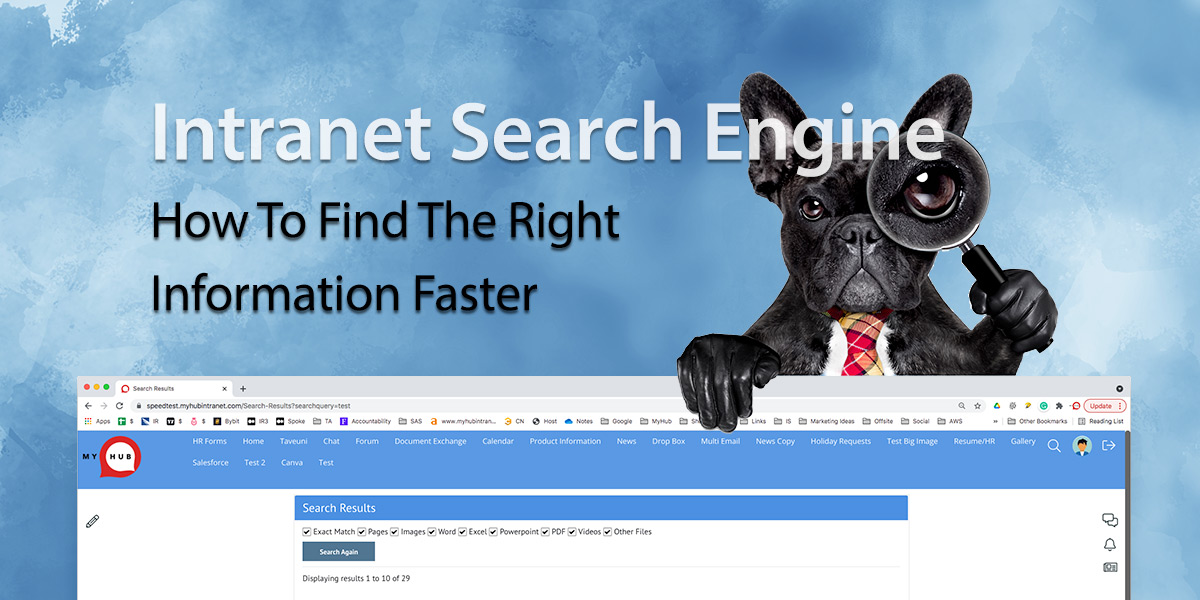Want to improve your organization’s efficiency, productivity, and performance? It’s a no-brainer, right? Every company wants to streamline processes, enhance internal communication, and maximize profits. But what’s the best and most cost-effective way to do so? Plenty of tools are available online that promise to deliver much. However, making the right decision is essential when budgets and time are tight. An employee intranet could be the perfect solution. The software offers a whole host of business benefits in a single platform.
This post defines a company intranet and discusses its main advantages. Finally, we present 42 compelling reasons why every business needs one.
What Is An Employee Intranet?
An intranet platform is a secure, private network exclusively for a company’s employees. It’s a central hub for internal communications and collaboration. And it allows employees to easily connect and share information with one another.
Just as your website is the outside face of your organization and brand, the intranet is the internal version. It comes packed with exciting modules and tools employees can use to support their work.
What’s The Purpose Of An Intranet?
So, what does a company intranet do? Well, think of an intranet as the home screen for your employees. Each day, your people log on to complete tasks and access company resources and tools needed for their jobs.
It could be simple: booking a meeting room, completing an expense claim, or checking the latest company news. Or maybe it’s more involved, like cross-team collaborations, project management, or knowledge sharing with coworkers.
Put simply, the purpose of a modern employee intranet is to support smooth and efficient business operations.
How Do You Create An Employee Intranet?
You can create an employee intranet using software downloaded from the web, such as WordPress or on-premise SharePoint. The intranet is then hosted on a company server.
This option can be tempting, as it allows you to develop a bespoke platform that perfectly matches your organization’s needs. However, don’t underestimate what’s involved. It requires a significant investment of time and resources in developing, testing, and piloting.
Often, although the software is capable of delivering a working intranet, it hasn’t been created for that specific purpose. Organizations usually end up buying extra add-ons and plug-ins to achieve the required functionality. And that makes it a challenging task, even for IT professionals.
A far more straightforward option is a cloud solution hosted by a specialist intranet provider. Cloud intranet providers use fully customizable pre-built intranet templates. These templates are tried and tested, so your site can be up and running in days rather than weeks. Easy to set up, no great technical expertise is needed to create a unique employee intranet.
Furthermore, cloud company intranets are usually provided at a fixed monthly price, often with unlimited users and data. Cost certainty, coupled with competitive pricing, is an unbeatable combination.
Therefore, it’s no surprise that most companies choose cloud intranet platforms over do-it-yourself options.
What Should Be On A Corporate Intranet?
The choice is yours. And that’s the great beauty of modern employee intranets. They are flexible, versatile platforms you customize to suit your organization’s needs.
However, while the customization options are almost endless, there are a few must-haves. These include the following:
- User-friendly interface for the intranet site
- Team and company news feeds
- Employee directory
- Document management and file sharing
- Library of company policies and training materials
- Search engine
- Employee communication channels, like instant messaging and interactive blogs
- Company calendar
- Automated workflows
42 Reasons Why Every Organization Needs An Employee Intranet
OK, so what benefits do employee intranets offer? The bottom line is that they deliver on a ton of business objectives.
Here, we present 42 compelling reasons your business needs an employee intranet for today’s digital workplace.
1. Enhance Internal Communications
Number one on the list is improved internal communications. The company’s intranet is perfect for keeping employees informed with timely, consistent corporate messages. It could be company news, product launches, or team announcements. Whatever the case, the news feed or what’s new button is the quickest way to spread the word.
2. Provide Gateway Access To The Digital Workplace
Modern intranets integrate seamlessly with your existing tools and enterprise systems. For example, MyHub’s software has over 60 integrations to the platforms you already use, including Salesforce, BambooHR, Monday.com, and many more.
Single sign-on access means employees interact with these tools within the intranet platform. No more toggling between screens or juggling multiple logins. It’s a time saver and a huge productivity boost.
3. Promote Dialogue With Employees
Use the intranet solution to develop an ongoing dialogue with staff and promote internal conversations across the entire company. Blogs and # channels allow employees to share new ideas and insights easily. Your people can also offer feedback and suggestions to company leadership. Instant messaging connects the organization’s employees and frontline workers who work in different locations or remotely.
4. Increase Employee Engagement
Plenty of research suggests engaged employees are happier, more productive, and stay longer with their employers. According to Gallup, organizations with highly engaged teams are 23 percent more profitable.
There’s much at stake, and a company intranet is an excellent tool for increasing employee engagement. Improved internal communication and the promotion of two-way conversations with management are essential first steps in boosting employee engagement.
5. Make Company Leadership More Accessible
In the quest to improve employee engagement, an intranet-based CEO blog or vlog is a great way to reach out directly to staff. Getting up close and personal makes the senior leadership team more open, accessible, and just like everyone else.
It’s a simple and highly effective tool. However, for maximum impact, it needs to be authentic and heartfelt rather than just a corporate mouthpiece.
6. Harvest Feedback With Surveys and Quizzes
Ready to take employee engagement to another level? Use the company intranet’s built-in surveys and quizzes tool to gauge how employees feel about various issues.
You may want feedback on a new employee benefits program. Or perhaps you want opinions on the revamped company logo. You can even create a snap poll on the preferred location for a team social outing. Whatever the case, quizzes and surveys are a versatile and highly effective way to engage with employees.
7. Track Employee Engagement With An Annual Survey
Many companies have developed intranet-based annual employee surveys to assess and measure progress in employee engagement. The data can also be used to compare and benchmark performance with others in the industry.
8. Enhance Knowledge Management
Most companies have vast amounts of data stored electronically. Often, that data is in multiple locations such as network drives, email, Google Drive, and on individual computers.
By contrast, employee intranets provide one central location for all company-critical information. Even better, the data is accessible by any employee at any time and place.
A central knowledge management system prevents overlap and duplication of effort, and an advanced search makes finding information so much easier. Employees can obtain the information they need directly, making the process more efficient and streamlined. This also means managing, organizing, and updating corporate knowledge is more straightforward and effective.
9. Facilitate Knowledge Transfer
Millions of baby boomers are retiring from the workplace every day. That’s a great deal of company knowledge simply walking out the door.
The company intranet is a valuable tool for ensuring effective knowledge transfer within your company. Different people learn in different ways, and the beauty of an intranet is that it offers multiple media to satisfy those varied needs. Take your pick from the following list of possibilities to support the transfer of knowledge:
- Podcasts
- How-to videos
- Wikis
- Webinars
- Quizzes and checklists
- Standard operating procedures
- Frequently asked questions.
10. Make Information Sharing Easier
The employee intranet is a central hub for all company-wide information when it comes to sharing and managing company documents, files, and data.
Moreover, the easy-to-understand site navigation ensures staff quickly locate and share all the information they need to do the job. It could be a product brochure, marketing materials, compliance checklist, or company policies. The intranet’s straightforward site setup simplifies sourcing and sharing information.
11. Harness The Power Of Google In Your Intranet
Many businesses already use Google Workspace – Google’s collaborative and cloud-based content-sharing apps. And now, you can leverage the power of Google Workspace alongside your intranet platform.
Embedding the apps directly in your intranet pages allows you to include vital background and context. Your people can view, edit, and collaborate online and in real-time from within the intranet.
12. Share And Collaborate More Effectively With Microsoft 365
If Microsoft 365 is your preferred office system and collaboration tool, you can do the same with embedded Word and Excel documents.
Combining these powerful tools in one cloud-based platform enhances productivity and generates savings with any time, anywhere access.
13. Do Away With Paper And Email Processes
There’s no denying it – paper and email-based processes are a cumbersome way of getting things done. How many of us are swamped with overflowing in-trays and unwieldy in-boxes? It’s just not an efficient way of operating. It’s also prone to errors, with the inevitable problem of information getting lost or misplaced.
Instead, why not automate business processes via the intranet for faster, more accurate operations? Improve processes and save time with online workflows. The company intranet will even route the workflow to the correct staff member for action.
14. Disseminate Information Quickly And Easily
The intranet’s content management system is the most efficient platform for fast information dissemination. Workers can access important documents 24/7 from any location. And it can be organized in a way that makes sense to your business. This self-service approach is empowering for employees. And it’s a great time-saver, so your people focus on more productive tasks rather than sourcing information.
15. Improve Discoverability With Advanced Search
Finding information quickly is a great advantage to efficient and effective business operations. The intranet’s advanced search function makes this happen. Users can quickly locate information and data by searching keywords within the content and title.
16. Break Down Information Silos
Information silos exist in some shape or form in pretty much every organization. An unwillingness or an inability to share data or hand over control are roadblocks to the flow of information. Employee intranets help break down those barriers. Instead, staff members can source information directly. And dynamic navigation and sophisticated search make information silos a thing of the past.
17. Provide More Opportunities For Collaboration
Two heads are indeed better than one. A collaborative work environment stimulates creativity and innovation throughout the company. The intranet incorporates collaboration tools that help employees come together. From brainstorming ideas and sharing insights to working together on documents and files, the platform connects staff to information and each other.
18. Support Flexible Working
The open-all-hours intranet allows employees to log on anytime and anywhere. Your people can access data while on their daily train commute or waiting for their morning take-out coffee.
Moreover, those workers who spend time on the road meeting with clients or in servicing roles can provide more responsive customer service. All critical company information is available at their fingertips regardless of location, making it mission-critical to today’s flexible digital workplace.
19. Connect With Remote Workers
If your business is fully remote or uses freelancers, the modern intranet allows you to connect with and retain oversight of these workers.
Remote working is here to stay. Experts predict 32.6 million Americans will be working remotely by 2025. That’s a whopping 417 percent increase on pre-pandemic levels. And by 2028, freelancers are expected to make up nearly 60 percent of the working population.
With these kinds of statistics, companies must have systems to meet operational challenges. A modern employee intranet will do just that.
20. Reach Every Worker With Mobile Intranets
Remote workers are only one side of the story. Up to 80 percent of the global workforce is deskless. Think retail, logistics, or manufacturing workers, to name just a few. However, 85 percent of US adults own a smartphone, making it a vital link to your deskless workforce.
Cloud intranets are fully accessible on mobile devices. Furthermore, most providers now offer dedicated intranet solution apps. This levels the playing field for your deskless or on-the-go workers. Now frontline workers can access the same information and functionality as their head office colleagues. Not only do you reach and connect with every employee, but productivity levels are also boosted.
21. Promote Your Company Culture
As an organization-wide tool, employee intranets can instill a sense of the company culture in new hires or freelancers. Use the platform to promote your vision and values and create a robust, unifying company culture.
22. Streamline Approvals Processes
There’s no escape. Every business needs to complete approval forms from payroll and network access to ordering supplies and expense claims. It’s a slow and challenging process via traditional paper forms and emails. Speed up the system and eliminate the potential for errors by automating these processes with online approval forms.
Whether using the employee intranet’s integrated forms builder or an embedded Google Form, create your own customized forms. Using drag-and-drop, it’s a simple process to design a professional-looking online form. You don’t need to be a technical whizz. Furthermore, the software can apply a few simple rules, and the completed form is automatically routed to the manager for action.
23. Online Employee Directories
We’ve all had that first day at work experience. You know the one – you meet a dozen colleagues and, within five minutes, have forgotten everyone’s names! An easily updated online employee directory eliminates that embarrassing problem. The new hire can refresh their memory by clicking on the faces or names within the online directory.
24. Enable Collaboration With Staff Profiles
Some businesses have taken things further with detailed online employee profiles. Alongside areas of expertise and current projects, you could include social intranet features like follows.
These features help connect employees and encourage collaboration. Furthermore, an online employee directory improves workers’ understanding of how things fit together, making them integral to employee onboarding.
25. Support Training And Development
Employees undergo training and development to update and develop their knowledge and skills. With a company intranet, creating simple e-learning pages is easy. Old-style, face-to-face training sessions are not always the most cost-effective or popular. Once you have added up venue charges, tutors’ fees, and the costs of staff cover, it can be an expensive exercise.
By comparison, intranet-based e-learning is a proven, cost-effective, and flexible development tool. And it can take many forms, including webinars, tutorials, quizzes, how-to videos, podcasts, or blogs. E-learning has the advantage of delivering consistent content to all learners while minimizing disruption to normal business activities.
And it’s popular with staff, allowing them to learn at their own pace and outside of regular working hours.
26. Keep An Online Log of Employees’ Professional Development
E-learning also provides an electronic record of training and achievement for each employee. This record is often essential for compliance and auditing purposes. And it’s a vital part of performance records.
27. Build Connections And Relationships Between Colleagues
Sharing best practices and engaging in comments, feedback, and # channels build those all-important social relationships in the workplace. Individuals develop a sense of connection and common purpose with their colleagues. And that’s critical for effective collaboration.
28. Safeguard Company Data
We don’t need to tell you email and online systems are vulnerable to cyberattacks. Safeguarding the security of commercially sensitive or confidential information must be a priority.
But if you think firewall is the name of a new band, it’s time to engage the experts. Cybersecurity is constantly evolving, and keeping one step ahead is a full-time job.
The intranet is a private, secure network, and the provider is responsible for its security. You can be confident that your data is protected with the latest security measures.
29. Keep The Entire Organization Updated On Company Events
The intranet’s company calendar keeps everyone in the loop on corporate events and deadlines. Your employees need never miss out, as the calendar feature is updated in real time, and the latest information is at their fingertips.
30. Celebrate Company Successes
Have you just won that important tender? Or have sales increased over the last month? Celebrate the big and the small wins through the corporate news feed. It’s hugely motivating for staff to see that the business is succeeding. It makes their contribution more meaningful. So, if you have something to shout about, make sure everyone hears the message loud and clear.
31. Promote Employee Recognition
And while we’re on the subject of celebrations, recognizing workers’ achievements is just as important. The intranet is the perfect forum for a company-wide employee recognition scheme. It could be the team that’s gone above and beyond or a worker with an innovative idea.
Whatever the case, acknowledging the contribution through the news feed or peer-to-peer recognition with a shoutout on team chat sends a clear signal to staff about their importance. Public validation motivates workers and enhances employee engagement across the board.
32. Promote Employee Wellness
Every responsible employer should make it a priority to look after the health and wellbeing of the workforce. After all, healthy and happy employees are less likely to be off sick. And they are more likely to be focused and productive when at work.
Promote the message with a health and wellness portal. As well as being a hub for work-related health issues, the portal can promote company wellbeing initiatives. It could be morning yoga classes, subsidized gym membership, or on-site health checks. Or why not get staff to share healthy recipes or find lunchtime walking buddies?
33. Encourage Mindfulness At Work
We’ve heard much lately about how mindfulness can improve staff members’ focus and creative energy. The example set by big names like Nike and Google means that more companies are experimenting with mindfulness programs.
Mindfulness is all about being in the moment and not allowing yourself to get distracted. Set up a login prompt encouraging workers to meditate or do breathing exercises and focus the mind before the day’s challenges begin.
34. Simplify Employee Onboarding
Every organization wants to assimilate new employees swiftly, so they hit the ground running. The employee intranet supports consistent, streamlined onboarding.
Consider creating an onboarding checklist and dedicated hub with all the resources a new hire could need. Plus, intranet-based onboarding for new employees means managers can track progress for compliance. And they can more easily step in with appropriate support when needed.
35. Provide More Effective Offboarding
Likewise, the employee intranet provides the opportunity to manage offboarding more effectively. Departing employees and their reasons for leaving offer a wealth of data on the health of any business. Whether it’s exit interviews, transferring knowledge, or managing termination paperwork, employee intranets make for a more efficient operation.
36. Improve The Employee Experience
There’s no doubt talent is scarce out there. In response, companies focus on creating a positive employee experience to attract and retain the best people. Employee engagement, wellness programs, and professional development are all critical elements. And so is intranet software that gives access to all the tools, information, and resources workers need.
37. Enhance The Customer Experience
It follows that employees who are empowered and equipped with the right resources will also provide enhanced customer service. You can take it a step further by developing a customer portal via the intranet for improved access and responsiveness.
38. Increase Engagement With Partners
And if your business relies on partners selling or reselling products, then an intranet-enabled partner portal delivers better engagement. Your partners can engage with you and exchange information 24/7. The benefits of greater control, oversight, and accountability are obvious and should not be underestimated.
39. Improve Quality Assurance Processes
Assuring the quality of your product or service is a fundamental task for any organization. And employee intranets make it easier and more streamlined. You can complete QA tasks in one flexible platform, from documenting procedures and developing process checklists to training, reviews, and data management.
40. Ensure Compliance With Corporate Responsibilities
Similarly, an employee intranet supports compliance and reporting procedures within your business. Whether it’s internal compliance processes, safety, and health requirements or achieving ISO accreditation, intranets tick all the boxes. They ensure all tasks are completed as required by legislation or industry guidance.
41. Standardize Project Management Processes
Every business involves some form of project management. But chances are different teams have different tools in place. There’s a vast choice of project management software out there. And most of us have a favorite that we like to use. However, that favorite tool may only be familiar to some.
Instead, set up a streamlined project management process on the corporate intranet. As workers already use the intranet daily, it’s an obvious and readily implemented solution. Files and updates are kept in a single place. Information sharing is straightforward with team chat and notifications, and @ mentions ensure no one misses an update.
42. Facilitate More Efficient And Effective Working
The bottom line is that your business will be more efficient and effective with all these great benefits. And that translates into increased productivity and profits.
What’s more, empowering employees with easy access to all the tools they need under one virtual roof makes for a more engaged, motivated and loyal workforce.
MyHub’s Modern Intranet: The #1 Choice To Engage Employees
Implementing an employee intranet is a no-brainer. MyHub’s platform is the software of choice for businesses of all shapes and sizes worldwide. Consistently rated highly on independent review sites, our modern intranet software is easy to set up and manage. Employee adoption isn’t an issue as your people will love using our platform.
Interested in finding out more? Sign up for a free demo or 14-day no-obligation trial and get started on your intranet project today.















